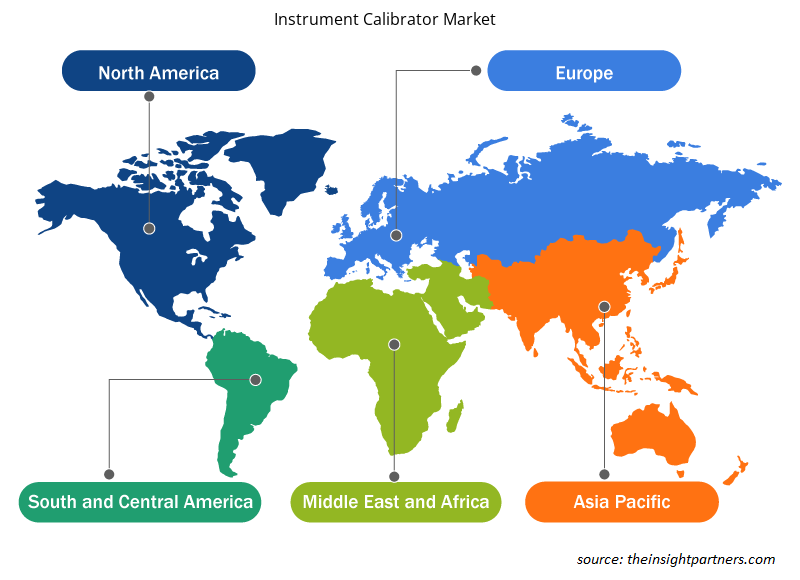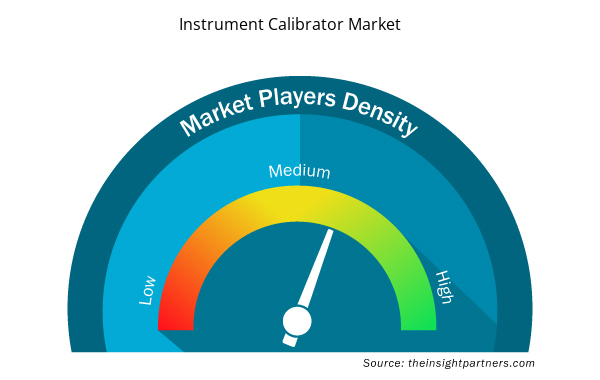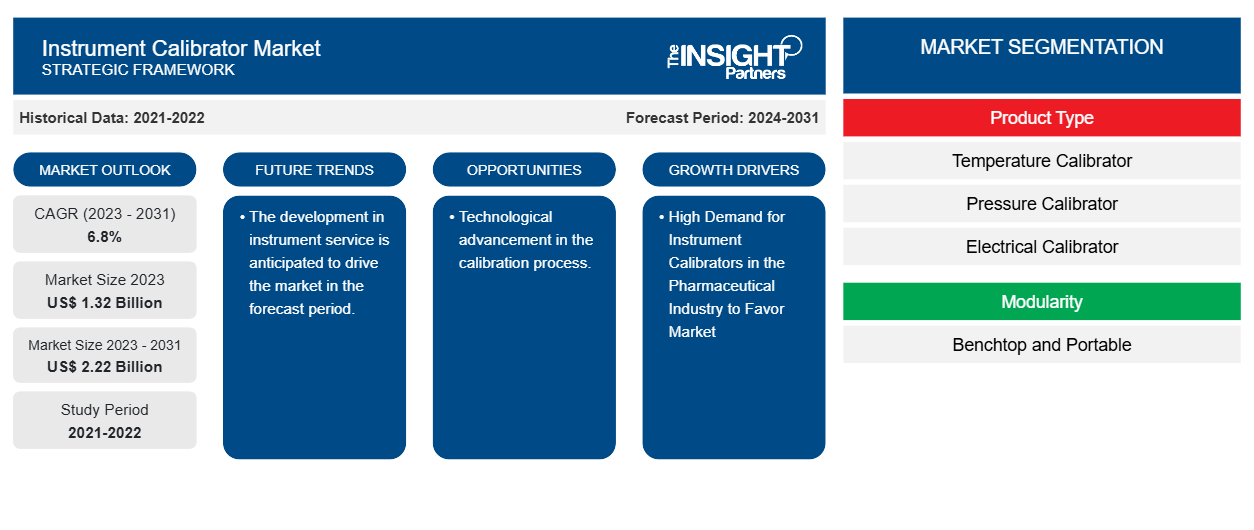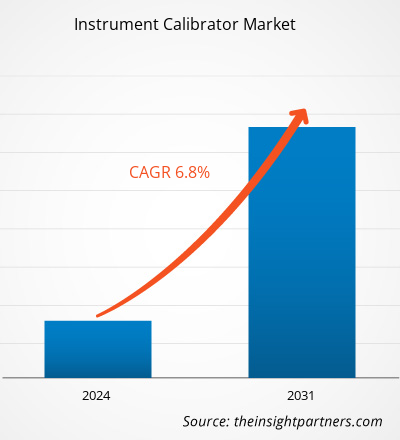Der Markt für Instrumentenkalibratoren soll von 1,32 Milliarden US-Dollar im Jahr 2023 auf 2,22 Milliarden US-Dollar im Jahr 2031 anwachsen. Der Markt wird zwischen 2023 und 2031 voraussichtlich eine durchschnittliche jährliche Wachstumsrate von 6,8 % verzeichnen. Die steigende Nachfrage aus der Pharmaindustrie sowie der technologische Fortschritt und die Erschwinglichkeit von Kalibratoren dürften weiterhin die wichtigsten Trends und Treiber des Marktes bleiben.
Marktanalyse für Instrumentenkalibratoren
Die Nachfrage nach Instrumentenkalibratoren dürfte wachsen, da die steigende Nachfrage aus der Pharma-, Luftfahrt- und Verteidigungsindustrie den Instrumentenkalibratormarkt antreibt. Darüber hinaus wird erwartet, dass verschiedene staatliche Vorschriften, technologische Fortschritte und Instrumentenkalibrierungen den Markt in den kommenden Jahren antreiben werden.
Marktübersicht für Instrumentenkalibratoren
Die Instrumentenkalibrierung ist ein wichtiger Bestandteil jedes Messsystems. Sie stellt sicher, dass die Instrumente ordnungsgemäß funktionieren und präzise Messwerte liefern. Dabei werden die Messwerte eines Instruments mit denen eines Referenzinstruments oder Kalibrators verglichen. Die Kalibrierung trägt dazu bei, Zuverlässigkeit, Genauigkeit, Sicherheit und die Einhaltung von Industriestandards sicherzustellen.
Passen Sie diesen Bericht Ihren Anforderungen an
Sie erhalten kostenlos individuelle Anpassungen an jedem Bericht, einschließlich Teilen dieses Berichts oder einer Analyse auf Länderebene, eines Excel-Datenpakets sowie tolle Angebote und Rabatte für Start-ups und Universitäten.
- Holen Sie sich die wichtigsten Markttrends aus diesem Bericht.Dieses KOSTENLOSE Beispiel umfasst eine Datenanalyse von Markttrends bis hin zu Schätzungen und Prognosen.
Treiber und Chancen auf dem Markt für Instrumentenkalibratoren.
Hohe Nachfrage nach Instrumentenkalibratoren in der Pharmaindustrie begünstigt den Markt
Die Instrumentenkalibrierung ist eine wichtige GMP- Aktivität in der Pharmaindustrie. Sie gewährleistet genaue Messungen wichtiger Instrumente und trägt zur Aufrechterhaltung der Produktqualität und -sicherheit bei. Bei diesem Prozess werden Instrumente mit bekannten Standards verglichen, um die Genauigkeit innerhalb festgelegter Toleranzen zu überprüfen. Pharmazeutische Anlagen können ohne Kalibrierung funktionieren. Die Einhaltung der strengen EMEA- /FDA-Vorschriften und ISO-Standards, ganz zu schweigen von der enormen Menge an Instrumenten, die regelmäßig kalibriert werden müssen, kann jedoch ein kostspieliger und zeitaufwändiger Prozess sein. Es werden große Mengen an Kalibrierungsdaten erstellt und archiviert, die insbesondere im Falle eines Audits bequem zugänglich sein müssen. Dies schafft eine enorme Nachfrage nach Instrumentenkalibrierung, was das Marktwachstum weiter ankurbelt.
Technologischer Fortschritt im Kalibrierungsprozess.
Technologische Fortschritte im Kalibrierungsprozess bergen enorme Chancen. Die Nachfrage nach automatisierter Software zur Verbesserung der Prozessgenauigkeit und -effizienz steigt. Mithilfe von Software zur Kalibrierungsautomatisierung können manuelle Prozesse und Verfahren in Aufgaben mit geringem oder sogar keinem Eingriff umgewandelt werden. Auch künstliche Intelligenz für Deep Learning und intelligente Kalibrierung gewinnt an Bedeutung. Täglich werden neue Anwendungen für diese Tools entdeckt, und die Kalibrierung ist einer der vielen Sektoren, die von diesem Technologieboom profitieren . Aufgrund der oben genannten Parameter wird erwartet, dass der technologische Fortschritt im Kalibrierungsprozess das Marktwachstum in den kommenden Jahren ankurbeln wird.
Marktbericht zu Instrumentenkalibratoren – Segmentierungsanalyse
Wichtige Segmente, die zur Ableitung der Marktanalyse für Instrumentenkalibratoren beigetragen haben, sind Produkttyp, Modularität und Branche.
- Basierend auf dem Produkttyp ist der Markt für Instrumentenkalibratoren in Temperaturkalibratoren , Druckkalibratoren, elektrische Kalibratoren und Multifunktionsprozesskalibratoren unterteilt. Das Segment der Temperaturkalibratoren dürfte im Prognosezeitraum einen erheblichen Anteil halten.
- Der Markt für Instrumentenkalibratoren basiert auf Modularität und ist sowohl als Tisch- als auch als tragbares Gerät erhältlich. Das tragbare Segment dürfte im Prognosezeitraum einen erheblichen Anteil halten.
- Nach Branchen ist der Markt in die Branchen Automobil, Luft- und Raumfahrt und Verteidigung, Elektronik, Lebensmittel und Getränke, Pharmazie, Öl und Gas sowie andere unterteilt. Das Automobilsegment dürfte im Prognosezeitraum einen erheblichen Marktanteil halten.
Marktanteilsanalyse für Instrumentenkalibratoren nach Geografie
Der geografische Umfang des Marktberichts zum Instrumentenkalibrator ist hauptsächlich in fünf Regionen unterteilt: Nordamerika, Asien-Pazifik, Europa, Naher Osten und Afrika sowie Süd- und Mittelamerika.
Nordamerika dominiert den Markt. Nordamerika umfasst Länder wie die USA, Kanada und Mexiko. Die Region verzeichnet ein beträchtliches Wachstum aufgrund von Faktoren wie der Verfügbarkeit von Tisch- und tragbaren Instrumentenkalibratoren in Industrie- und Entwicklungsländern. Darüber hinaus erhöht die hohe Nutzung tragbarer Kalibratoren aufgrund ihrer benutzerfreundlichen Oberfläche und erschwinglichen Preise ihre weltweite Nachfrage. Darüber hinaus steigert der Fokus auf Forschung und Entwicklung den technologischen Fortschritt in der Region. Außerdem gibt es in der Region eine große Anzahl wichtiger Hersteller auf dem Markt. Aufgrund all dieser Parameter gewinnt der Markt in Nordamerika an Zugkraft.
Regionale Einblicke in den Instrumentenkalibratormarkt
Die regionalen Trends und Faktoren, die den Markt für Instrumentenkalibratoren im Prognosezeitraum beeinflussen, wurden von den Analysten von Insight Partners ausführlich erläutert. In diesem Abschnitt werden auch die Marktsegmente und die Geografie von Instrumentenkalibratoren in Nordamerika, Europa, im asiatisch-pazifischen Raum, im Nahen Osten und Afrika sowie in Süd- und Mittelamerika erörtert.

- Erhalten Sie regionale Daten zum Markt für Instrumentenkalibratoren
Umfang des Marktberichts zu Instrumentenkalibratoren
| Berichtsattribut | Details |
|---|---|
| Marktgröße im Jahr 2023 | 1,32 Milliarden US-Dollar |
| Marktgröße bis 2031 | 2,22 Milliarden US-Dollar |
| Globale CAGR (2023 - 2031) | 6,8 % |
| Historische Daten | 2021-2022 |
| Prognosezeitraum | 2024–2031 |
| Abgedeckte Segmente | Nach Produkttyp
|
| Abgedeckte Regionen und Länder | Nordamerika
|
| Marktführer und wichtige Unternehmensprofile |
|
Marktteilnehmerdichte: Der Einfluss auf die Geschäftsdynamik
Der Markt für Instrumentenkalibratoren wächst rasant, angetrieben durch die steigende Nachfrage der Endnutzer aufgrund von Faktoren wie sich entwickelnden Verbraucherpräferenzen, technologischen Fortschritten und einem größeren Bewusstsein für die Vorteile des Produkts. Mit steigender Nachfrage erweitern Unternehmen ihr Angebot, entwickeln Innovationen, um die Bedürfnisse der Verbraucher zu erfüllen, und nutzen neue Trends, was das Marktwachstum weiter ankurbelt.
Die Marktteilnehmerdichte bezieht sich auf die Verteilung von Firmen oder Unternehmen, die in einem bestimmten Markt oder einer bestimmten Branche tätig sind. Sie gibt an, wie viele Wettbewerber (Marktteilnehmer) in einem bestimmten Marktraum im Verhältnis zu seiner Größe oder seinem gesamten Marktwert präsent sind.
Die wichtigsten auf dem Markt für Instrumentenkalibratoren tätigen Unternehmen sind:
- AMETEK Inc.
- Baker Hughes Unternehmen
- Extech-Instrumente
- Fluke Corporation
- Yokogawa Electric Corporation
- WIKAAlexander Wiegand SE & co. KG
Haftungsausschluss : Die oben aufgeführten Unternehmen sind nicht in einer bestimmten Reihenfolge aufgeführt.

- Überblick über die wichtigsten Akteure auf dem Markt für Instrumentenkalibrierung
Neuigkeiten und aktuelle Entwicklungen zum Markt für Instrumentenkalibratoren
Der Markt für Instrumentenkalibratoren wird durch die Erhebung qualitativer und quantitativer Daten nach Primär- und Sekundärforschung bewertet, die wichtige Unternehmensveröffentlichungen, Verbandsdaten und Datenbanken umfasst. Nachfolgend sind einige der Entwicklungen auf dem Markt für Instrumentenkalibratoren aufgeführt:
- ABB hat mit dem Bau einer neuen 12.000 Quadratmeter großen Kalibrierhalle im Industriepark neben seiner bestehenden 200.000 Quadratmeter großen Produktionsstätte in Bartlesville, Oklahoma, begonnen. Die Investition wird die Kalibrierungskapazitäten des Unternehmens stärken und den Kunden ein hohes Maß an Qualität und Genauigkeit in der gesamten Durchflussmesserpalette von ABB bieten. Darüber hinaus wird das Angebot des Unternehmens „Made in America“ weiter ausgebaut. (Quelle: ABB-Unternehmenswebsite, Januar 2024)
- Dracal Technologies gab die Unterzeichnung einer Vereinbarung zwischen Dracal Technologies und Essco Calibration Laboratory in den USA bekannt. Essco ist ein nach ISO/IEC 17025:2017 akkreditiertes Labor mit über 50 Jahren Erfahrung in der Kalibrierung von Messgeräten. (Quelle: Dracal Technologies, Unternehmenswebsite, November 2023)
Marktbericht zu Instrumentenkalibratoren – Umfang und Ergebnisse
Der Bericht „Marktgröße und Prognose für Instrumentenkalibratoren (2021–2031)“ bietet eine detaillierte Analyse des Marktes, die die folgenden Bereiche abdeckt:
- Marktgröße und Prognose für Instrumentenkalibratoren auf globaler, regionaler und Länderebene für alle abgedeckten wichtigen Marktsegmente.
- Markttrends für Instrumentenkalibratoren sowie Marktdynamik wie treibende Faktoren, Hemmnisse und wichtige Chancen.
- Detaillierte PEST/Porters Five Forces- und SWOT-Analyse.
- Marktanalyse für Instrumentenkalibratoren, die wichtige Markttrends, globale und regionale Rahmenbedingungen, wichtige Akteure, Vorschriften und aktuelle Marktentwicklungen abdeckt.
- Branchenlandschaft und Wettbewerbsanalyse, einschließlich Marktkonzentration, Heatmap-Analyse, prominenten Akteuren und aktuellen Entwicklungen auf dem Markt für Instrumentenkalibratoren.
- Detaillierte Firmenprofile.
- Historische Analyse (2 Jahre), Basisjahr, Prognose (7 Jahre) mit CAGR
- PEST- und SWOT-Analyse
- Marktgröße Wert/Volumen – Global, Regional, Land
- Branche und Wettbewerbsumfeld
- Excel-Datensatz


- Thermal Energy Storage Market
- Pharmacovigilance and Drug Safety Software Market
- Electronic Signature Software Market
- Fishing Equipment Market
- Predictive Maintenance Market
- Piling Machines Market
- Emergency Department Information System (EDIS) Market
- Dairy Flavors Market
- Environmental Consulting Service Market
- Sterilization Services Market

Report Coverage
Revenue forecast, Company Analysis, Industry landscape, Growth factors, and Trends

Segment Covered
This text is related
to segments covered.

Regional Scope
North America, Europe, Asia Pacific, Middle East & Africa, South & Central America

Country Scope
This text is related
to country scope.
Häufig gestellte Fragen
North America is anticipated to dominate the instrument calibrator market in 2023.
Increasing demand from the pharmaceutical industry and technological advancement and affordability of callibrators are likely to remain key trends and drivers in the market.
The development in instrument service is anticipated to drive the market in the forecast period.
The key players holding majority shares in the global instrument calibrator market are AMETEK Inc., Baker Hughes Company, Extech Instruments, Fluke Corporation, Yokogawa Electric Corporation, and WIKAAlexander Wiegand SE & co. KG, Additel, Beamex Oy Ab, Calmet, Spectris.
The global instrument calibrator market is expected to reach US$ 2.22 billion by 2031.
The expected CAGR of the instrument calibrator market is 6.8%.
Trends and growth analysis reports related to Electronics and Semiconductor : READ MORE..
The Insight Partners performs research in 4 major stages: Data Collection & Secondary Research, Primary Research, Data Analysis and Data Triangulation & Final Review.
- Data Collection and Secondary Research:
As a market research and consulting firm operating from a decade, we have published and advised several client across the globe. First step for any study will start with an assessment of currently available data and insights from existing reports. Further, historical and current market information is collected from Investor Presentations, Annual Reports, SEC Filings, etc., and other information related to company’s performance and market positioning are gathered from Paid Databases (Factiva, Hoovers, and Reuters) and various other publications available in public domain.
Several associations trade associates, technical forums, institutes, societies and organization are accessed to gain technical as well as market related insights through their publications such as research papers, blogs and press releases related to the studies are referred to get cues about the market. Further, white papers, journals, magazines, and other news articles published in last 3 years are scrutinized and analyzed to understand the current market trends.
- Primary Research:
The primarily interview analysis comprise of data obtained from industry participants interview and answers to survey questions gathered by in-house primary team.
For primary research, interviews are conducted with industry experts/CEOs/Marketing Managers/VPs/Subject Matter Experts from both demand and supply side to get a 360-degree view of the market. The primary team conducts several interviews based on the complexity of the markets to understand the various market trends and dynamics which makes research more credible and precise.
A typical research interview fulfils the following functions:
- Provides first-hand information on the market size, market trends, growth trends, competitive landscape, and outlook
- Validates and strengthens in-house secondary research findings
- Develops the analysis team’s expertise and market understanding
Primary research involves email interactions and telephone interviews for each market, category, segment, and sub-segment across geographies. The participants who typically take part in such a process include, but are not limited to:
- Industry participants: VPs, business development managers, market intelligence managers and national sales managers
- Outside experts: Valuation experts, research analysts and key opinion leaders specializing in the electronics and semiconductor industry.
Below is the breakup of our primary respondents by company, designation, and region:

Once we receive the confirmation from primary research sources or primary respondents, we finalize the base year market estimation and forecast the data as per the macroeconomic and microeconomic factors assessed during data collection.
- Data Analysis:
Once data is validated through both secondary as well as primary respondents, we finalize the market estimations by hypothesis formulation and factor analysis at regional and country level.
- Macro-Economic Factor Analysis:
We analyse macroeconomic indicators such the gross domestic product (GDP), increase in the demand for goods and services across industries, technological advancement, regional economic growth, governmental policies, the influence of COVID-19, PEST analysis, and other aspects. This analysis aids in setting benchmarks for various nations/regions and approximating market splits. Additionally, the general trend of the aforementioned components aid in determining the market's development possibilities.
- Country Level Data:
Various factors that are especially aligned to the country are taken into account to determine the market size for a certain area and country, including the presence of vendors, such as headquarters and offices, the country's GDP, demand patterns, and industry growth. To comprehend the market dynamics for the nation, a number of growth variables, inhibitors, application areas, and current market trends are researched. The aforementioned elements aid in determining the country's overall market's growth potential.
- Company Profile:
The “Table of Contents” is formulated by listing and analyzing more than 25 - 30 companies operating in the market ecosystem across geographies. However, we profile only 10 companies as a standard practice in our syndicate reports. These 10 companies comprise leading, emerging, and regional players. Nonetheless, our analysis is not restricted to the 10 listed companies, we also analyze other companies present in the market to develop a holistic view and understand the prevailing trends. The “Company Profiles” section in the report covers key facts, business description, products & services, financial information, SWOT analysis, and key developments. The financial information presented is extracted from the annual reports and official documents of the publicly listed companies. Upon collecting the information for the sections of respective companies, we verify them via various primary sources and then compile the data in respective company profiles. The company level information helps us in deriving the base number as well as in forecasting the market size.
- Developing Base Number:
Aggregation of sales statistics (2020-2022) and macro-economic factor, and other secondary and primary research insights are utilized to arrive at base number and related market shares for 2022. The data gaps are identified in this step and relevant market data is analyzed, collected from paid primary interviews or databases. On finalizing the base year market size, forecasts are developed on the basis of macro-economic, industry and market growth factors and company level analysis.
- Data Triangulation and Final Review:
The market findings and base year market size calculations are validated from supply as well as demand side. Demand side validations are based on macro-economic factor analysis and benchmarks for respective regions and countries. In case of supply side validations, revenues of major companies are estimated (in case not available) based on industry benchmark, approximate number of employees, product portfolio, and primary interviews revenues are gathered. Further revenue from target product/service segment is assessed to avoid overshooting of market statistics. In case of heavy deviations between supply and demand side values, all thes steps are repeated to achieve synchronization.
We follow an iterative model, wherein we share our research findings with Subject Matter Experts (SME’s) and Key Opinion Leaders (KOLs) until consensus view of the market is not formulated – this model negates any drastic deviation in the opinions of experts. Only validated and universally acceptable research findings are quoted in our reports.
We have important check points that we use to validate our research findings – which we call – data triangulation, where we validate the information, we generate from secondary sources with primary interviews and then we re-validate with our internal data bases and Subject matter experts. This comprehensive model enables us to deliver high quality, reliable data in shortest possible time.


 Holen Sie sich ein kostenloses Muster für diesen Bericht
Holen Sie sich ein kostenloses Muster für diesen Bericht